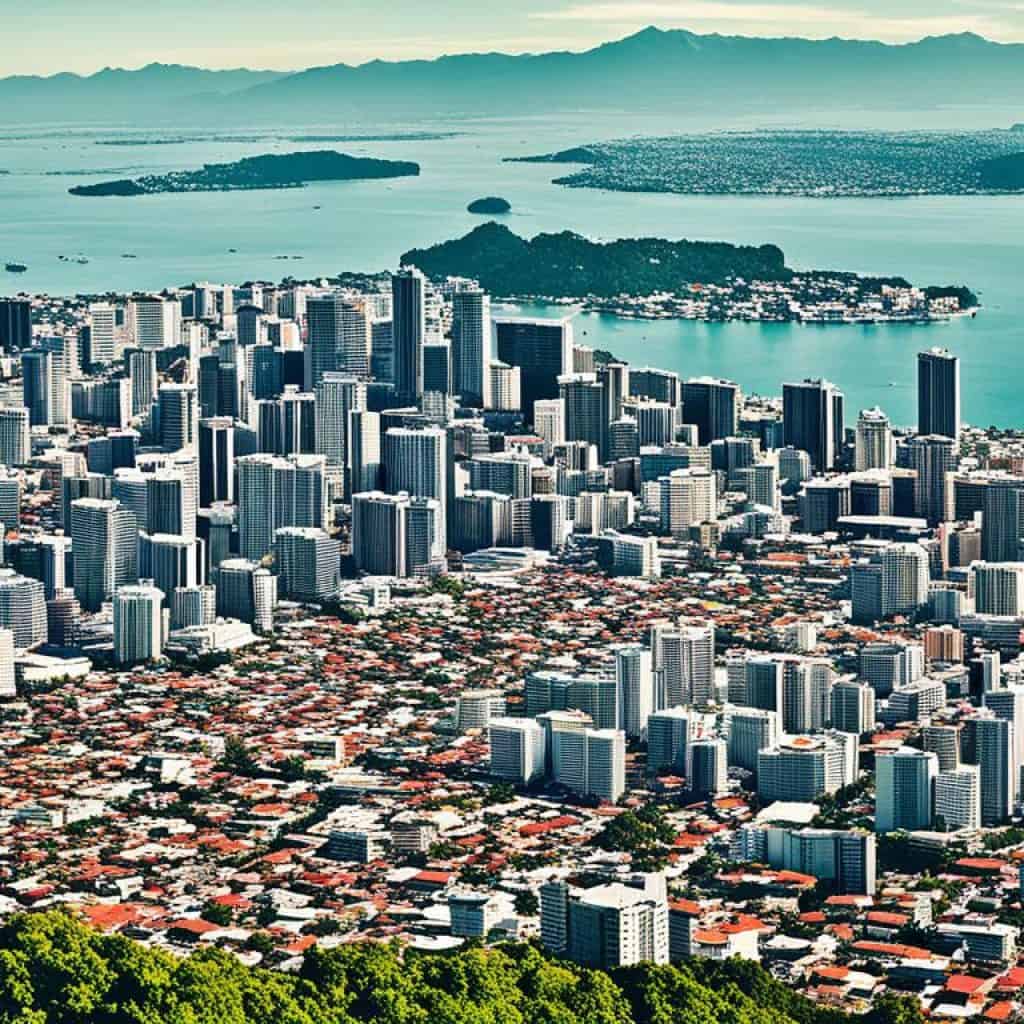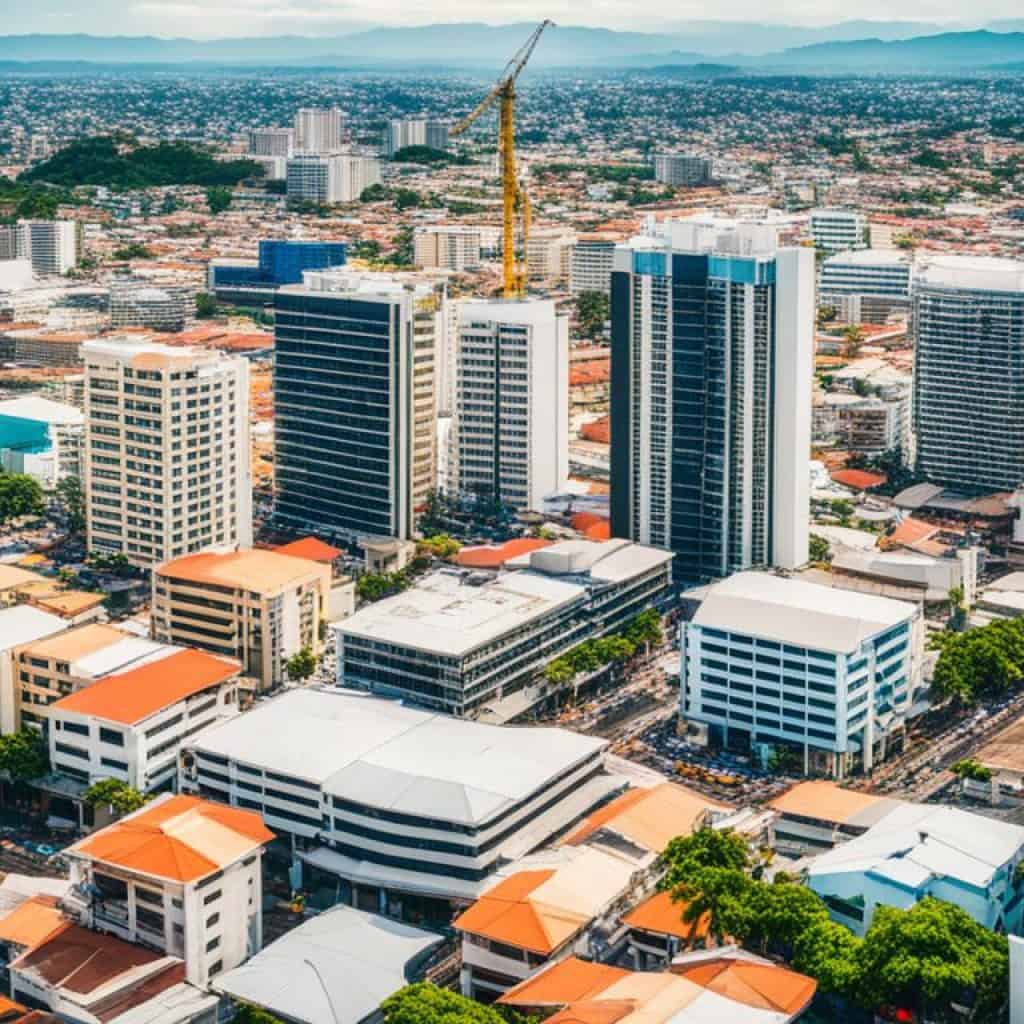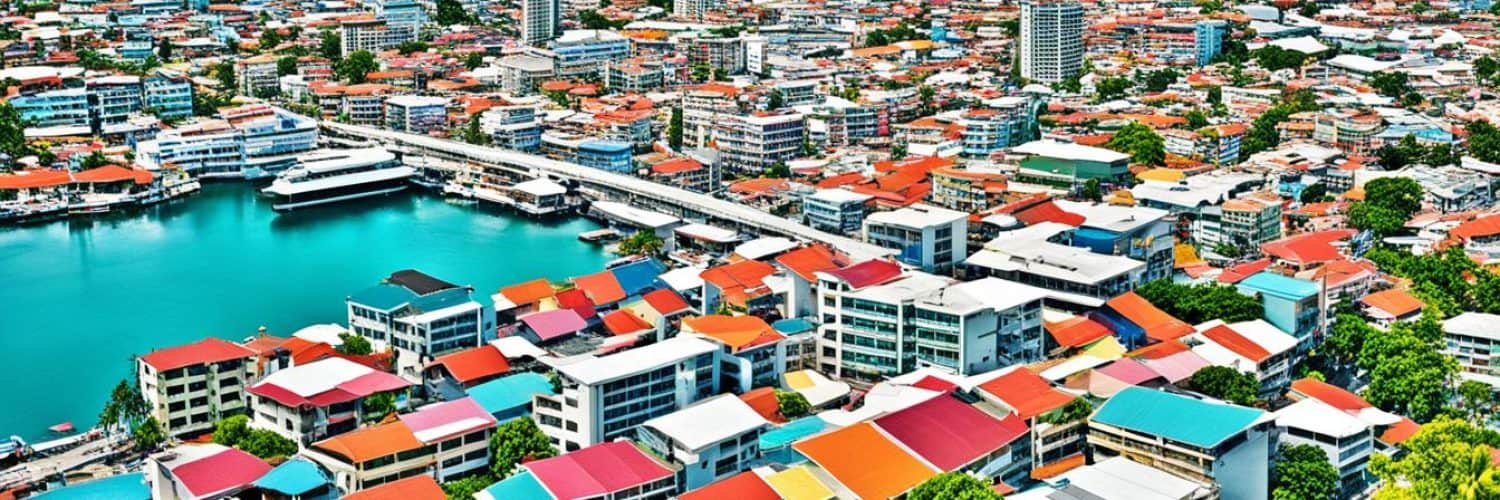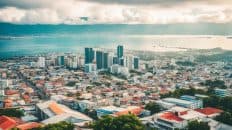Have you ever wondered about the population of Cebu City and how it has changed over the years? How does Cebu’s population compare to its population in 1950? And what factors contribute to its growth? Get ready to explore the fascinating world of Cebu’s population and demographics.
Key Takeaways:
- Cebu City’s population in 2024 is estimated to be 1,042,613, a significant increase from the population of 178,256 in 1950.
- The city has experienced a 1.72% annual change in population, reflecting a growth rate of 1.72%.
- Understanding Cebu’s population growth and demographics is crucial for effective urban planning and development strategies.
- Stay tuned to discover more about Cebu’s population trends, density, and future projections.
- Learn how Cebu City’s population contributes to its economic, cultural, and regional importance in the Philippines.
Population Growth Trends in Cebu City
The population of Cebu City has consistently grown over the years, reflecting a trend of increasing inhabitants. From 1950 to 2024, the city’s population has experienced a significant growth of over 864,000 people.
These population growth trends highlight the dynamic nature of Cebu City and its attractiveness as a place to live and work. With a diverse range of opportunities and a thriving economy, people from various backgrounds are drawn to the city, contributing to its expanding population.
The growth rate has fluctuated over time, but the average annual change in population stands at 1.72%. This indicates a consistent increase in the number of residents in the city, reflecting positive population trends.
As Cebu City continues to evolve and offer more opportunities, it is expected that population growth will persist in the coming years. The city’s strategic location, economic development, and quality of life contribute to its appeal, attracting individuals and families who seek a vibrant urban environment.
“Cebu City’s population growth is a testament to its allure and potential. As more people recognize the city’s advantages, we can expect the population to continue to expand in the years ahead.”
– Mayor of Cebu City
Cebu City Population Density
Located in the Central Visayas region of the Philippines, Cebu City boasts a land area of 315.00 square kilometers. With a population density of 3,100 people per square kilometer, the city is a vibrant, bustling hub of activity. Cebu City’s high population density is a testament to its urban nature, with a large number of residents living within a relatively small area.
The image above visualizes the population density of Cebu City, with data indicating the concentration of people in its urban agglomeration. The city’s skyline, filled with tall buildings, reflects the high population density and the vibrancy of urban life. It is this density and concentration of inhabitants that contribute to the dynamic and lively atmosphere that Cebu City is renowned for.
Cebu City’s urban agglomeration not only encompasses the city proper but also extends to its adjacent suburban areas. This amalgamation of populations within a relatively small geographic area creates a thriving cosmopolitan environment, giving rise to diverse communities and cultures.
Urban Living at its Finest
The high population density of Cebu City results in a rich tapestry of lifestyles, cultural experiences, and economic opportunities. The city’s urban landscape is teeming with business centers, educational institutions, shopping districts, and residential areas, all within close proximity to one another.
“Cebu City offers the best of urban living. Its high population density creates a unique ecosystem where residents can easily access amenities, services, and recreational facilities. The city’s compactness promotes connectivity and fosters a sense of community.”
The urban density of Cebu City also contributes to its economic growth and development. With a concentration of businesses, industries, and economic activities, the city serves as a thriving economic hub in the region. These opportunities attract individuals from various backgrounds, resulting in a diverse and cosmopolitan population.
The Challenges and Benefits
While high population density offers numerous advantages, such as efficient resource allocation and vibrant social interactions, it also presents challenges. The demand for housing, transportation, and infrastructure development poses ongoing challenges to urban planners and policymakers.
However, the ability of a city like Cebu to accommodate and sustain a high population density speaks volumes about its resilience and adaptability. The city’s infrastructure continues to evolve to meet the needs of its growing population, ensuring that residents enjoy a high quality of life.
| Key Facts | Statistics |
|---|---|
| Land Area | 315.00 square kilometers |
| Population Density | 3,100 people per square kilometer |
| Urban Agglomeration | Includes city proper and adjacent suburban areas |
The table above provides key statistics related to Cebu City’s population dynamics. It highlights the city’s land area and its impressive population density of 3,100 individuals per square kilometer. Additionally, it emphasizes the inclusion of adjacent suburban areas within the urban agglomeration, giving a holistic representation of the population concentration in Cebu City.
As Cebu City continues to grow and evolve, its population density remains a defining characteristic of its urban landscape. The city’s ability to accommodate a large number of residents within a comparatively small area is a testament to its vibrancy, cultural diversity, and economic vitality.
Cebu City Census Data
The census data provides valuable information about the population of Cebu City. It includes data on population size, growth rate, and other demographic factors. The census data is collected periodically and helps in understanding the demographic composition of the city, including age distribution, gender ratio, and ethnicity.
Census data plays a crucial role in urban planning, resource allocation, and policy-making. Governments and organizations use this data to make informed decisions about infrastructure development, healthcare provisions, education facilities, and other essential services.
Let’s take a closer look at the key census data for Cebu City:
| Data | Value |
|---|---|
| Population Size | 1,042,613 |
| Growth Rate | 1.72% |
| Age Distribution |
|
| Gender Ratio |
|
| Ethnicity |
|
These statistics provide insights into the composition of the population in terms of age, gender, and ethnicity. Understanding these factors is crucial for developing policies that cater to the diverse needs and requirements of the residents of Cebu City.
Historical Population Trends in Cebu City
The population statistics of Cebu City provide valuable insights into the historical trends and changes in the city’s inhabitants. From 1950 to 2024, the population has experienced significant growth, increasing from 178,256 to 1,042,613. This upward trajectory indicates a continuous rise in the number of people residing in Cebu City.
The population growth rate has fluctuated over time, but it has remained consistently positive. This dynamic presents a compelling picture of a thriving and expanding city. The population statistics allow for a comprehensive analysis of the trends and patterns that have shaped the demographic landscape of Cebu City.
The increase in population has implications for various aspects of the city’s development and urban planning. It highlights the need for adequate infrastructure, healthcare facilities, and educational institutions to accommodate the growing number of residents. The population statistics serve as a valuable tool for policymakers and researchers to understand the evolution and dynamics of Cebu City’s inhabitants over the years.

Cebu City Demographics
Cebu City is a vibrant and diverse city with a rich mix of residents from various backgrounds and cultures. The demographics of the city provide valuable insights into the social and cultural dynamics that shape Cebu City’s unique identity.
Age distribution plays a significant role in understanding the population of Cebu City. The city has a balanced mix of different age groups, ranging from young children and adolescents to working-age adults and seniors. This diverse age distribution contributes to the city’s vibrant energy and varied perspectives.
The gender ratio in Cebu City is relatively balanced, with men and women contributing equally to the city’s population. This gender equality fosters a sense of inclusivity and provides equal opportunities for both men and women in various aspects of life, including education, employment, and social interactions.
The ethnic composition of Cebu City reflects the multicultural nature of the Philippines. The city is home to people of different ethnicities, including Visayan, Chinese, Spanish, and various indigenous groups. This ethnic diversity adds richness and depth to the city’s cultural heritage.
Furthermore, Cebu City embraces its diversity and promotes inclusivity and tolerance among its residents. This cultural exchange and acceptance foster a sense of harmony and unity among different communities, contributing to the city’s overall social cohesion.
“Cebu City’s demographics showcase a diverse and inclusive community, reflecting the city’s vibrant energy and multicultural heritage.”
Understanding the demographics of Cebu City is essential for urban planning and development. It helps policymakers and city officials create effective strategies that cater to the needs and aspirations of the city’s diverse population. By considering factors such as age distribution, gender ratio, and ethnicity, Cebu City can continue to thrive and provide a high quality of life for all its residents.
Social and Cultural Landscape
The social and cultural landscape of Cebu City is shaped by its diverse demographics. The city hosts a wide range of cultural events and festivals that celebrate the traditions and heritage of its residents. These events serve as avenues for cultural exchange, fostering a sense of pride and unity among different communities.
Notably, Cebu City’s demographics also contribute to its culinary scene. The city is known for its diverse food options, ranging from local delicacies to international cuisine. This culinary diversity reflects the multicultural nature of the city and provides residents and visitors alike with an opportunity to explore different flavors.
| Ethnicity | Percentage |
|---|---|
| Visayan | 70% |
| Chinese | 15% |
| Spanish | 5% |
| Indigenous Groups | 10% |
The table above showcases the ethnic composition of Cebu City’s population, with Visayan being the largest ethnic group comprising 70% of the population. This data underscores the cultural diversity within the city and emphasizes the importance of inclusivity and acceptance for a harmonious community.
Cebu City’s Role as a Regional Center
Cebu City holds a crucial position as the regional center for Central Visayas, playing an integral role in various sectors that shape the region’s development.
- In terms of commerce, Cebu City serves as a bustling hub for trade and business activities, attracting both domestic and international investments. Its strategic location and well-established infrastructure contribute to its status as a regional economic powerhouse.
- As a key trading center, the city facilitates the movement of goods and services, acting as the primary domestic shipping port for around 80% of the Philippines’ shipping companies.
- In the industrial realm, Cebu City boasts a thriving manufacturing sector that contributes significantly to the region’s economy. The city’s industrial activities drive employment opportunities and further stimulate economic growth.
- Education is another area where Cebu City shines as a regional center, hosting numerous prestigious universities and colleges. Students from across Central Visayas flock to the city for quality education, enhancing the region’s overall knowledge and human resource capabilities.
- Cebu City’s rich culture and history make it a cultural epicenter, attracting tourists who flock to experience its vibrant festivals, historical landmarks, and lively arts scene.
- The city also serves as a regional healthcare hub, housing state-of-the-art medical facilities and advanced healthcare services. Its top-notch healthcare infrastructure enhances the quality of life for residents and supports the well-being of the entire region.
The strategic significance of Cebu City as a regional center cannot be overstated. Its economic, cultural, and educational influence radiates throughout Central Visayas, making it a vital engine of growth and development.
The Economic Impact
As a regional center, Cebu City’s economic importance permeates the surrounding areas. Its thriving business ecosystem attracts investments, stimulates job creation, and propels the region towards sustainable growth.
The Cultural Significance
With its vibrant festivals, historical sites, and diverse artistic community, Cebu City represents the cultural heart of Central Visayas. Its cultural influence extends beyond borders, enriching the region’s heritage and fostering a sense of identity.
The Educational Hub
Cebu City’s universities and educational institutions draw students from far and wide, contributing to a vibrant academic landscape and enhancing the intellectual capital of Central Visayas.
| Key Sectors | Role in Regional Development |
|---|---|
| Commerce and Trade | Driving economic growth and attracting investments |
| Manufacturing | Generating employment opportunities and fostering industrial development |
| Education | Enhancing knowledge resources and human capital in the region |
| Culture and Tourism | Promoting regional identity and attracting visitors |
| Healthcare | Providing advanced medical services and healthcare infrastructure |
Cebu City as a Trading Center
Cebu City, located in the southern region of the Philippines, is renowned as the prime trading center in the area. With its strategic location and well-developed infrastructure, the city serves as the main domestic shipping port, hosting approximately 80% of the country’s domestic shipping companies.
Being a vital hub for trade and commerce, Cebu City facilitates the smooth movement of goods and services. Its extensive network of transportation systems and logistics support ensures efficient trade operations, making it a preferred destination for businesses and traders.
The city’s strategic location in the southern Philippines allows it to connect with various regions both locally and internationally. Its proximity to major international shipping routes and its well-connected airport make it an ideal gateway for imports and exports.
Cebu City’s prime trading center status is further enhanced by its vibrant wholesale and retail sectors. The city boasts a wide range of markets, malls, and commercial centers, attracting not only local consumers but also international buyers.
“Cebu City’s prime trading center status is a testament to its economic significance and the opportunities it offers for businesses in the southern Philippines.”
This bustling trading hub presents ample opportunities for entrepreneurs and investors. The city’s favorable business climate, supportive government initiatives, and skilled workforce contribute to its attractiveness as a trading destination.
Cebu City’s Trading Sector Highlights:
- A well-established and diverse range of import and export businesses
- A comprehensive network of transport and logistics infrastructure
- An extensive array of markets, malls, and commercial centers
- Wide-ranging product offerings, catering to local and international demands
- Efficient customs clearance processes and supportive government policies
Cebu City’s Economic Growth
Cebu City, known as the Queen City of the South, has experienced impressive economic growth since the 1990s, earning the nickname “Ceboom.” This economic boom has transformed the city into a thriving center for various industries, contributing to its overall development and improving the quality of life for its residents.
The economic growth of Cebu City can be attributed to several key sectors. The city has become a prominent hub for the business process outsourcing industry, with numerous multinational companies setting up operations here. This sector has created a significant number of jobs and attracted investments, driving economic growth and prosperity.
In addition to outsourcing, manufacturing plays a vital role in Cebu City’s economic success. The city is home to a diverse range of manufacturing companies, including electronics, textiles, and furniture production. These industries contribute to the city’s export capabilities and generate employment opportunities.
Tourism is another sector that has contributed to Cebu City’s economic growth. The city’s rich cultural heritage, beautiful beaches, and historical sites attract a large number of domestic and international tourists. This influx of visitors boosts the local economy, creating jobs in hospitality, transportation, and other related industries.
Furthermore, construction is flourishing in Cebu City, with numerous infrastructure projects underway. These projects include commercial buildings, residential areas, and transportation networks. The construction sector drives growth, stimulates economic activity, and enhances the city’s overall infrastructure.
The combination of these sectors has propelled Cebu City’s economic growth, positioning it as an important economic center in the Philippines. The city’s rising prosperity has had a positive impact on the standard of living for its residents, providing them with increased opportunities for employment, education, and quality healthcare.
To illustrate Cebu City’s economic growth, take a look at the table below:
| Year | Gross Domestic Product (GDP) | Unemployment Rate |
|---|---|---|
| 2015 | $XX billion | 5% |
| 2016 | $XX billion | 4.5% |
| 2017 | $XX billion | 4% |
As shown in the table, Cebu City’s GDP has been consistently growing over the years, accompanied by a decline in the unemployment rate. This data demonstrates the city’s robust economic performance and its position as a key player in the country’s economy.
Overall, Cebu City’s economic growth has been fueled by a combination of sectors such as business process outsourcing, manufacturing, tourism, and construction. This growth has not only boosted the city’s economic standing but has also improved the quality of life for its residents, establishing Cebu City as a thriving economic center in the Philippines.

Cebu City’s Urban Agglomeration
The urban agglomeration of Cebu City encompasses not only the city’s population but also the adjacent suburban areas. This holistic view of the urban agglomeration allows for a comprehensive understanding of the population dynamics and the overall urbanization process in Cebu City.
Cebu City’s urban agglomeration is an interconnected network of communities, merging urban, suburban, and rural areas. It reflects the growth and development of the city, showcasing the expansion of residential, commercial, and industrial zones beyond the city limits.
The inclusion of suburban areas in the urban agglomeration paints a more accurate picture of the city’s population and its impact on the surrounding regions. It highlights the interdependence and intricate relationships between different localities, providing insights into the socioeconomic ties, transportation networks, and shared resources.
Within the urban agglomeration, residents enjoy the convenience of easy access to the city’s amenities, such as educational institutions, healthcare facilities, and employment opportunities. It fosters a sense of community and collective identity, as people from diverse backgrounds come together to shape the future of Cebu City.
“The urban agglomeration of Cebu City exemplifies the ongoing urbanization process, illustrating how the city extends its influence beyond its administrative boundaries. It showcases the interconnectedness of various communities and the multifaceted nature of urban development.”
This comprehensive understanding of the urban agglomeration is crucial for urban planners and policymakers. It enables them to make informed decisions regarding infrastructure development, housing projects, transportation systems, and environmental conservation efforts.
The urban agglomeration of Cebu City is a dynamic entity, constantly evolving and adapting to the changing needs and aspirations of its residents. It serves as a testament to the city’s progress and growth, encapsulating the spirit of urban life in the vibrant and thriving Cebu City.
Geography and Location of Cebu City
Cebu City, the capital of the province of Cebu, is situated in the Central Visayas region of the Philippines. It occupies a strategic location at the center of the eastern seaboard of Cebu Island. Surrounding the city are various towns and cities, including Balamban, Toledo, Lapu-Lapu, and Talisay. This prime location enables Cebu City to enjoy accessibility and connectivity to other parts of the country, further enhancing its prominence.
“Cebu City’s geographical position at the heart of Cebu Island plays a vital role in its growth and development.”
The Importance of Cebu City in the Philippines
Cebu City holds significant importance in the Philippines due to its economic, cultural, and historical significance. Known as the Queen City of the South, Cebu City exerts a powerful influence and holds a prominent position in the country.
The city’s economic growth is a key factor in its importance. Cebu City serves as a major economic hub, attracting investments and driving development. Its strategic location and well-developed infrastructure make it an ideal destination for businesses, contributing to the overall economic growth of the Philippines.
“Cebu City’s economic importance and vibrant business climate make it one of the prime destinations for trade and commerce in the country.”
In addition to its economic significance, Cebu City is rich in cultural heritage. The city’s historical landmarks, ancient temples, and vibrant festivals attract tourists from all over the world. It is a melting pot of diverse cultures and traditions, making it a center for cultural exchange and exploration.
Cebu City also plays a crucial role in the region. As the regional center for Central Visayas, the city influences various sectors, including commerce, education, healthcare, and tourism. Its regional importance further enhances its overall significance within the Philippines.
“Cebu City’s cultural heritage and regional importance make it a city of immense value in the Philippines.”
Overall, Cebu City’s economic growth, cultural heritage, and regional importance contribute to its significance in the Philippines. Its role as a major economic hub and cultural center, coupled with its historical and regional influence, positions Cebu City as a vital city in the country’s development and progress.
Future Projections for Cebu City’s Population
Based on current trends and growth rates, projections for the Cebu City population indicate continued growth. The city’s population is expected to increase in the coming years, reflecting the ongoing urbanization and development. These projections play a vital role in urban planning and resource allocation, ensuring that the necessary infrastructure and services are in place to support the growing population.
As Cebu City continues to attract investments and foster economic growth, its vibrant and dynamic environment serves as a magnet for job seekers and migrants from other regions. These factors contribute to the upward trend in population, with the city becoming a hub of opportunity and progress.
Efforts to improve the quality of life, expand educational institutions, enhance healthcare services, and provide sustainable infrastructure demonstrate the city’s commitment to nurturing its growing populace. By anticipating future population growth through meticulous projections, decision-makers can effectively plan for the needs of the expanding community.
Understanding these Cebu City population projections helps stakeholders in various sectors make informed decisions relating to housing, transportation, education, healthcare, and urban development. By aligning resources with projected population growth, Cebu City can ensure the well-being and prosperity of its residents.
Projections at a Glance:
To provide a clearer overview of the expected Cebu City population growth in the coming years, here is a breakdown of the projected figures:
| Year | Population |
|---|---|
| 2025 | 1,080,000 |
| 2030 | 1,200,000 |
| 2035 | 1,320,000 |
| 2040 | 1,440,000 |
These projections indicate a steady increase in the population of Cebu City over the next few decades. It is crucial for local authorities and urban planners to utilize this data to ensure that adequate infrastructure, services, and resources are available to meet the needs of the growing population.
Conclusion
In conclusion, Cebu City’s population has experienced significant growth over the years, with projections indicating continued growth in the future. The city’s population size, growth rate, demographics, and economic importance contribute to its overall significance in the Philippines. Understanding the population trends and demographics is crucial for effective urban planning and development strategies.


















Add comment